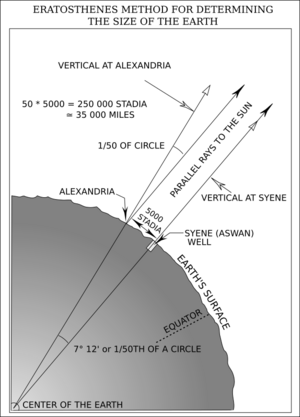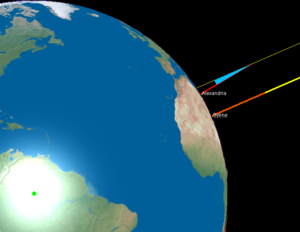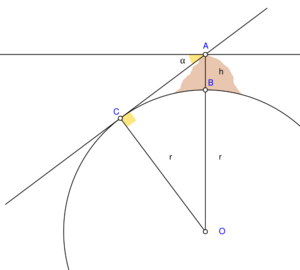Earth's circumference facts for kids

The Earth's circumference is the total distance around our planet. Imagine a giant measuring tape wrapped all the way around the Earth!
If you measure around the equator (the imaginary line around the middle of the Earth), it's about 40,075 kilometers (24,901 miles). If you measure from the North Pole to the South Pole and back, it's a bit shorter, about 40,008 kilometers (24,859 miles).
Knowing the Earth's size has been super important for navigation for a very long time. It helps sailors and explorers know how far they've traveled.
Contents
Why Measuring Earth's Size Matters
Measuring the Earth's circumference has helped us in many ways. It was crucial for ancient sailors to find their way across oceans. It also helped scientists create important units of measurement that we still use today.
Defining Our Units of Measurement
Did you know that the Earth's circumference helped define the length of a nautical mile and even the metre?
- The Nautical Mile: In the 1600s, the nautical mile was created. It was meant to be one minute of latitude. Imagine dividing the Earth's circumference from pole to pole into 21,600 equal parts. One of those parts is roughly a nautical mile! This was very useful for navigation at sea.
- The Metre: In 1793, France decided to define the metre based on the Earth's size. They wanted the distance from the North Pole to the equator to be exactly 10 million metres (or 10,000 kilometres). Scientists measured a part of the Earth's curve to figure this out. Because of tiny measurement differences, the Earth's polar circumference is actually 40,008 kilometers, not exactly 40,000. But it's very close!
Who First Measured Earth's Size?
People have tried to measure the Earth for thousands of years. Here are some of the most famous attempts.
Eratosthenes' Clever Idea

Around 240 BC, a Greek scholar named Eratosthenes made the first known scientific measurement of the Earth's circumference. He lived in Alexandria, Egypt.
He heard that in a city called Syene (modern-day Aswan), which was south of Alexandria, the Sun was directly overhead at noon on the summer solstice. This meant a stick standing straight up would cast no shadow.
In Alexandria, however, a stick would cast a shadow at the same time. Eratosthenes measured the angle of this shadow. It was about 7 degrees.
He knew the distance between Syene and Alexandria was about 5,000 stadia (an ancient unit of distance). Since 7 degrees is about 1/50th of a full circle (360 degrees), he figured the Earth's circumference must be 50 times the distance between the two cities.
So, he multiplied 5,000 stadia by 50, which gave him 250,000 stadia. This was an amazing calculation for his time! Depending on the exact length of the "stadion" he used, his estimate was very close to the actual size of the Earth. He was only off by a small amount, perhaps 2% to 15%.
Other Early Measurements
- Posidonius: Another Greek scholar, Posidonius, also tried to measure the Earth's circumference. He used the position of a star called Canopus. He observed that this star was just on the horizon in Rhodes, but higher in the sky in Alexandria. He estimated the Earth's circumference to be about 240,000 stadia, which was also quite accurate.
- Aryabhata: Around AD 525, an Indian mathematician named Aryabhata calculated the Earth's diameter. His measurement, using a unit called "yojanas," was also quite close to the actual size.
Measurements in the Islamic Golden Age

During the Islamic Golden Age, around AD 830, a group of Muslim astronomers were asked by Caliph Al-Ma'mun to measure the Earth's circumference. They used surveying methods and got a result that was very close to the modern value.
Later, around 1037, a brilliant scholar named Al-Biruni came up with a new, clever way to measure the Earth. Instead of needing two locations, he used trigonometry from a single spot! He climbed a mountain, measured its height, and then looked at the angle from the mountain top down to the horizon. Using math, he could then figure out the Earth's circumference. This was a very advanced method for his time.
Christopher Columbus's Mistake
About 1,700 years after Eratosthenes, Christopher Columbus studied different ideas about the Earth's size. Sadly, he chose to believe an estimate that said the Earth was much smaller than it actually is. He thought the Earth's circumference was about 25% smaller than Eratosthenes had calculated.
If Columbus had trusted Eratosthenes's more accurate number, he would have known that the land he reached was not Asia, but a completely New World! His mistake led him to believe he had reached India, when he had actually landed in the Americas.
See also
- Earth radius
- Spherical Earth
- Nautical mile

